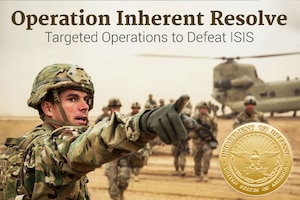SOUTHWEST ASIA, Sept. 21, 2017 — U.S. and coalition military
forces continued to attack the Islamic State of Iraq and Syria yesterday,
conducting 23 strikes consisting of 41 engagements, Combined Joint Task Force
Operation Inherent Resolve officials reported today.
Operation Inherent resolve
Officials reported details of yesterday's strikes, noting
that assessments of results are based on initial reports.
Strikes in Syria
In Syria, coalition military forces conducted 15 strikes
consisting of 15 engagements against ISIS targets.
-- Near Abu Kamal, a strike engaged an ISIS tactical unit
and destroyed a vehicle.
-- Near Raqqa, 14 strikes engaged two ISIS tactical units
and destroyed seven fighting positions, a vehicle, two logistics nodes, a
vehicle-borne improvised explosive device and a vehicle-borne-IED factory.
Strikes in Iraq
In Iraq, coalition military forces conducted eight strikes
consisting of 26 engagements against ISIS targets:
-- Near Beiji, a strike destroyed a vehicle and a mortar
system.
-- Near Huwijah, two strikes engaged an ISIS tactical unit
and destroyed a vehicle and a command-and-control node.
-- Near Rawah, five strikes engaged two ISIS tactical units
and destroyed two vehicles, two tactical vehicles, two weapons caches, a
command-and-control node, a mortar system, a heavy machine gun, a vehicle-borne
IED, an ISIS bridge an ISIS staging area and an IED.
Additional Sept. 19 Strikes
Additionally, officials provided details today on 16 strikes
consisting of 20 engagements conducted Sept. 19 in Syria and Iraq for which the
information was not available in time for yesterday's report:
-- Near Raqqa, 15 strikes engaged two ISIS tactical units,
destroyed 17 vehicles and 13 fighting positions, and suppressed a fighting
position.
-- Near Huwijah, a strike destroyed five vehicle-borne IEDs
and two vehicles and damaged two ISIS supply routes.
Part of Operation Inherent Resolve
These strikes were conducted as part of Operation Inherent
Resolve, the operation to destroy ISIS in Iraq and Syria. The destruction of
ISIS targets in Iraq and Syria also further limits the group's ability to
project terror and conduct external operations throughout the region and the
rest of the world, task force officials said.
The list above contains all strikes conducted by fighter,
attack, bomber, rotary-wing or remotely piloted aircraft; rocket-propelled
artillery; and some ground-based tactical artillery when fired on planned targets,
officials noted.
Ground-based artillery fired in counterfire or in fire
support to maneuver roles is not classified as a strike, they added. A strike,
as defined by the coalition, refers to one or more kinetic engagements that
occur in roughly the same geographic location to produce a single or cumulative
effect.
For example, task force officials explained, a single
aircraft delivering a single weapon against a lone ISIS vehicle is one strike,
but so is multiple aircraft delivering dozens of weapons against a group of
ISIS-held buildings and weapon systems in a compound, having the cumulative
effect of making that facility harder or impossible to use. Strike assessments
are based on initial reports and may be refined, officials said.
The task force does not report the number or type of
aircraft employed in a strike, the number of munitions dropped in each strike,
or the number of individual munition impact points against a target.








No comments:
Post a Comment